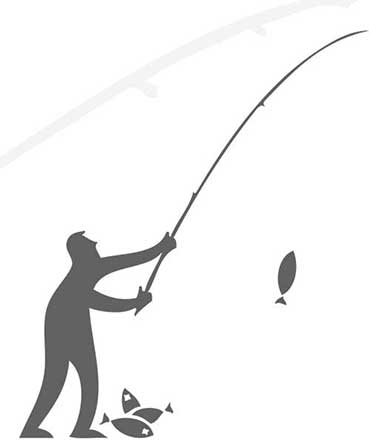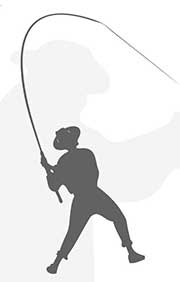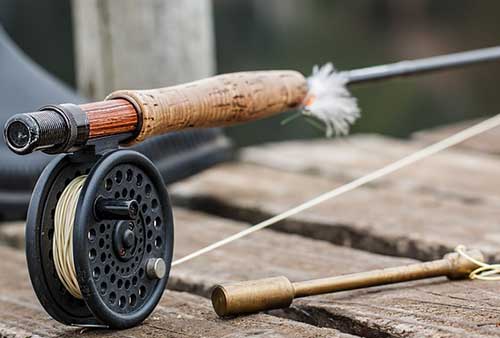Fly fishing is one of the most relaxing ways to spend an afternoon. There is little which can compare to being surrounded by the sounds of nature while you attempt to outwit a hungry fish, tricking it into taking your fly.
But fly fishing is also full of terminologies and equipment which can be confusing, especially for a beginner. Having the proper equipment is vital to experiencing an enjoyable angling adventure, so let me help you by explaining one of those terms – rod action.
The fly rod may look like a fancy stick used to hold the line, but it is much more than that. It allows you to cast the line (an attached fly) with precision by controlling its direction and distance.
Once a fish is hooked, it provides the muscle necessary to land the fish without breaking the delicate line.
Of course, this only works if you select the proper rod, and a significant aspect of choosing the correct rod revolves around a rod’s action. A fly rod’s “action” refers to its stiffness, the portion of the rod which flexes and how quickly it recovers or stops flexing at the end of a cast. The action is expressed as “fast,” “medium” or “slow” and categorized based upon where on the blank the rod will bend during a cast.
Types of Rod Actions
Fast Action

A fast action rod will be the stiffest of the three categories with the least amount of flexibility.
These rods will flex only in the upper third nearest the tip and are considered the heaviest and most difficult to master because an excellent cast relies on near-perfect technique by the angler.
Probably not the first choice for the beginner, but that doesn’t mean it does not have a place in your fly fishing arsenal.
If targeting almost any saltwater species, especially big tarpon or bonefish on a distant flat, they are a must have.
They are also extremely helpful if targeting trophy trout from a drift boat on a larger western river. But if you are starting out on a local mountain trout stream you will find it both too cumbersome and difficult to manage for landing smaller species in confined spaces.
PROS
CONS
Medium Action
A medium or moderate action rod is a good “middle of the road” rod regarding flexibility. It bends near the mid-point of the blank, or approximately half way between the butt and tip.

This provides the user with a nice combination of flexibility and stiffness. It allows you to present not only a broad range of flies and streams with precision but also have the strength necessary to fight almost any freshwater species.
This also allows the medium action rod to offer decent casting distance even in moderate wind conditions while also allowing for more subtle presentation on smaller waters. For these reasons, the medium action rod is considered the most versatile of the three actions and a must in almost every fly fisherman’s rod collection.
PROS
CONS
Slow Action

A slow action rod flexes near the butt, or handle, and this means that when the rods are cast, the entire length will bend and whip – resulting in a very slow recovery time which is where it gets its name.
As with the fast action rod, beginners may find it difficult to develop the momentum necessary to push and line and fly out.
This also means that the rod itself acts as a sort of shock absorber and allows for the use of lighter line and smaller tippets without fear of breaking.
Slow action rods tend to be shorter and lesser weight than either of the other classifications.
PROS
CONS
Alternate Classification Terms

Although these are the three traditional classifications, you will find that many manufacturers are now using combined or hybrid classifications as well, such as “fast-medium” or “medium-slow.” These hybrid actions will incorporate features of each action depending on the particular model or maker.
Some manufacturers have also moved towards describing the action regarding stiffness: using stiff to replace fast and soft to replace slow.
If you encounter these variations, remember the terms are still describing the rod’s flexibility, and a stiff action will react the same as a fast action rod, a soft action the same as a slow rod, etc.
Regardless of the manufacturer, the specific term used by the action described will still provide similar pros and cons, suitable for the same situations described above.
An Introduction to Fly Rod Actions – Conclusion
So there you have it, rod action in a nutshell. Of course only reading about it will not truly teach you which is the best action for you and your particular fishing style or scenario. Before making a final selection, I suggest visiting your local fly fishing shop, speaking to the pro staff, obtain few suggestions and then trying each of those in the casting pond.
Another excellent option is to visit a fishing expo, where you can often see and demonstrate a wide variety of rods in a single setting. Only then will you find the particular action which not only meets your specific fishing needs but also feel best in your hand.
The bad news is that fly fishing is addictive and regardless of how good your first rod may be, it is rarely ever your only rod. Before long you will find it is no longer a matter of which rod you should buy, but which rod you should use today.